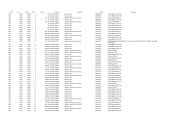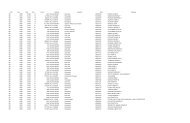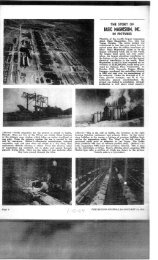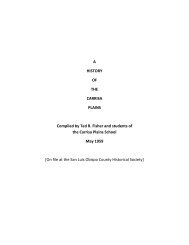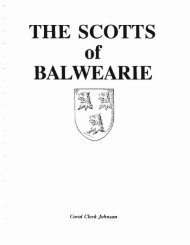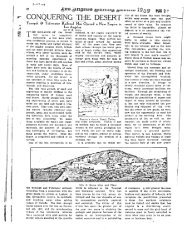1940 - part 2 - Vredenburgh.org
1940 - part 2 - Vredenburgh.org
1940 - part 2 - Vredenburgh.org
Create successful ePaper yourself
Turn your PDF publications into a flip-book with our unique Google optimized e-Paper software.
An important element in the successful<br />
uae of the equipment is the free floating<br />
piston or hammer designed in the<br />
Worthington drill. This piston has but<br />
one function to perfonn-that is, to hammer<br />
the drill steel. The rotation of the<br />
steel is entirely independent of this piston<br />
or hammer action. A simple, balancedgear<br />
air motor is employed, a feature commonly<br />
called "independent rotation." The<br />
ability of the hammer to continue func<br />
~tioning, even should rotation stop, supplies<br />
-the means for driving the steel backward<br />
out of the stuck position, enabling the independent<br />
rotation to immediately pick up<br />
its function and keep the steel free. The<br />
possibility of Ustuck steel'" is lessened to<br />
a point where it might be said, for all<br />
practical purposes, to be non-existent. The<br />
operator soon learns all these desirable<br />
peculiarities of this independent rotation<br />
and hammering action and by understanding<br />
it avoids "stuck steel."<br />
At Picacho the equipment included<br />
Worthington WD-33 Tower wagon drills<br />
each equipped with the special vacuum<br />
sample collector and operated by Worthington<br />
816-cubic foot, two-stage, aircooled<br />
full Diesel portable compressors.<br />
It readily can be understood that as the<br />
work progressed, experience was gained<br />
which resulted in modifications not only in<br />
some of the equipment, but in the method<br />
cpursued. In this work the Worthington<br />
staff cooperated with the Picacho <strong>org</strong>anization<br />
to develop and perfect the vacuum<br />
sampling method.<br />
The original vacuum sample collectors<br />
were redesigned and improved and, today,<br />
a sample collector to fit practically any<br />
condition is available. Likewise, many improvements<br />
in the technique of drilling<br />
and the utilization of accessories were<br />
made and adopted.<br />
HILE the Picacho problem was prin.<br />
W cipally to develop ore for an open<br />
pit, Dew applications of the vacuum sampling<br />
system are rapidly being made. One<br />
of the most important of these is its adaptation<br />
to underground sampling.<br />
At Picacho there were 45,536 feet of<br />
vertical holes drilled. There also were<br />
drilled some 656 feet of hole from underground<br />
setups, using one of the rock drills<br />
from a Worthington WD-33 wagon drill<br />
placed on a sc.rew-feed shell. Setups were<br />
made using a tripod.<br />
Operators have been quick to grasp the<br />
importance of underground applications of<br />
vacuum sampling.<br />
Surface drilling was carried out successfully<br />
by E. L. Jones and E. H. Page at the<br />
Blossom mine near Ogilby, California. At<br />
this property the equipment consisted of a<br />
Worthington WD·83 Tower wagon drill,<br />
vacuum sample collector, and 316-cubic<br />
foot compressor similar to those used at<br />
Picacho.<br />
Another user of the outfit for surface<br />
drilling was lack .McIver of Oatman, Ari<br />
""IlL Mciver drilled 16 test holes on the<br />
Indian Springs mine near Kingman, An·<br />
" .. IlL Test-pit checking proved the method<br />
remarkably accurate and satisfactory. The<br />
A Worthin,ton 521 drill operating at the<br />
Fortuna mine. In the collar of the hole the<br />
collector hood i. in place and to it i.<br />
attached the .uction ho.. which cony.y.<br />
, the cutting. and dual to the vacuum<br />
.ample collector.<br />
cost of operation was low. The total cost,<br />
including purchase of equipment and operation<br />
expense, was at least $35,'000 less<br />
than would have prevailed if the work had<br />
been done by standard underground methods.<br />
,<br />
A number of deep holes were drilled<br />
horizontally at the old Fortuna mine 18<br />
miles southeast of Yuma, Arizona. The<br />
famous old Fortuna mine with its myriad<br />
of faults in schist and other complex geological<br />
features is a geologist's paradise.<br />
The property produced roughly $2,500,000<br />
some years ago and provided a handsome<br />
profit to the stockholders. The ore was<br />
cut off by two faults, one on the strike<br />
of the vein and another on the dip, which<br />
resulted finally in closing the mine. Th~<br />
present operators have opened up the Suicide<br />
Shaft and have encountered some ore<br />
Lat. mod.l ..... pl. coll.ctor for<br />
aurfac. a.e.<br />
Which has paid for a portion of the d.<br />
velopment work being done. The drill<br />
holes were put in to compile geologiea1<br />
data, and otherwise check the fonnationa.<br />
Drilling conditions were adverse to the Nth<br />
degree. The ground was heavy, fitchel'}',<br />
and damp. However, drilling proved to be<br />
far more economical than previous drift.<br />
ing costs and supplied the necessary geological<br />
information required for the solution<br />
of the problem at hand.<br />
The Burton Bros. (Clifford Burton and<br />
Cecil Burton) of Rosamond, California, are<br />
at present engaged in 8 program of drilling<br />
and sampling at their several mines, utilising<br />
the vacuum method of sampling. Work<br />
has been started at the Ruth mine near<br />
Trona, California, and is to be followed by<br />
work at the Davenport and at the Tropico<br />
mines.<br />
The Ruth mine is still in the development<br />
stage but treats, by the cyanide leaching<br />
process, approximately 70 tons of gold ore<br />
per day. The gold occurs in a quartz vein,<br />
carrying iron oxides. The country rock<br />
in the area is granite with intrusions of<br />
monzonite porphyry. These intrusions Borne<br />
times carry subsidiary quartz veins with<br />
values in gold. The drilling qualities of<br />
the ore may be described 88 medium hard.<br />
The equipment used in drilling and<br />
sampling underground at the ·Ruth mine<br />
consists of Worthington Model·240 ham·<br />
mer drills (air motor feed) and vacuum<br />
sample collectors. Air is supplied by<br />
Worthington full Diesel, 315-cubic foot.,<br />
two--stage compressors.<br />
Similar steel and bits are used 88 at Pi*<br />
cacho (l\4·inch hollow-round steel with d&<br />
tachable cross bits) except that lengths ~<br />
. provided for steel changes to meet underground<br />
conditions. Lengths of rod now in<br />
use include l'h feet, 2 \0 feet, 5 feet, and<br />
10 feet. Attention is given to maintaining<br />
a minimum number of' couplings in the<br />
hole.<br />
Holes may be drilled at any angle<br />
through a full circle of 360 degrees. The<br />
different angles require different technique,<br />
both in drilling and in taking tht<br />
sample.<br />
When a horizontal hole is desired, the<br />
hole may be drilled more easily by pointing<br />
the hole up at a small angle. Underground,<br />
for steep holes, it is sometim~<br />
necessary to cut out head room for the<br />
drill in \lrder to handle the rods.<br />
Holes drilled from the surface also may<br />
be at any angle provided the proper wagon~<br />
drill mounting is used.<br />
HE following procedure is used to se·<br />
Tcure accurate samples. In ord~n&!7<br />
rock a a-inch cross bit is used to start the<br />
hole. The suction hose from the sample<br />
collector is held at the face while starting<br />
the hole, to catch all the dust and cuttings.,<br />
When the hole is about 18 inches deep a<br />
metal dust-hood, which holds the SUCtlOD<br />
hose and catches the cuttings, is<br />
in the hole. In the event the ground at<br />
the collar is soft or very ravelly, a J.araer<br />
bit is used to start the hole, in order to<br />
penn~rtion of a 4-inch casing to<br />
vide a good working collar.<br />
P.., • • ,<br />
I<br />
THE .MINING JOURNAL t ... SEPTEMBER 16,




